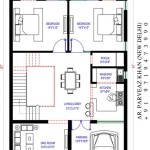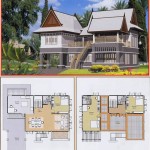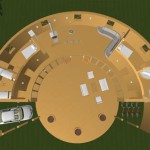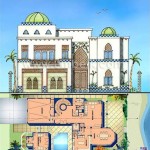House Plan In 3D View App: A Comprehensive Guide
The design and construction of a house are significant undertakings, requiring careful planning and visualization. Traditionally, architects and designers relied on blueprints and 2D drawings to convey their vision. However, with the advent of technology, mobile applications offering 3D house plan views have emerged as powerful tools, transforming the way homeowners, architects, and builders interact with house designs. These applications allow users to explore spatial relationships, experiment with layouts, and visualize the final product in a realistic and immersive manner. This article delves into the world of house plan applications offering 3D views, exploring their features, benefits, and the impact they have on the residential design process.
House plan applications that incorporate 3D view functionality offer a significant advantage over traditional 2D representations. They provide a more intuitive understanding of the space, allowing users to perceive the depth, scale, and overall aesthetics of the design. This enhanced visualization capability can lead to better decision-making during the planning phase, reducing the likelihood of costly mistakes during construction. Furthermore, these applications often come equipped with a range of features that facilitate the design process, such as furniture placement tools, material selection options, and the ability to simulate different lighting conditions.
Key Point 1: Enhanced Visualization and Spatial Understanding
The primary advantage of using a house plan application featuring 3D viewing capabilities lies in its ability to provide enhanced visualization. Traditional 2D blueprints can be challenging for individuals without architectural training to interpret. 3D models, on the other hand, offer a more realistic and immersive representation of the design. This allows homeowners to easily understand the spatial relationships between different rooms, visualize the flow of movement, and assess the overall layout of the house.
The ability to rotate and examine the 3D model from various angles provides a comprehensive understanding of the design. Users can "walk through" the virtual house, exploring each room and appreciating the interplay of light and shadow. This level of detail allows for a more informed assessment of the design's aesthetics and functionality. Furthermore, many applications offer the ability to customize the 3D model with different materials, colors, and furniture, allowing users to experiment with various design options and visualize the final product in a personalized manner.
The impact of enhanced visualization extends beyond aesthetic appreciation. It also facilitates the identification of potential design flaws or inconsistencies early in the planning phase. For example, a homeowner might realize that a particular room is too small or that the placement of windows does not adequately provide natural light. By identifying these issues before construction begins, costly and time-consuming modifications can be avoided.
Consider a scenario where a homeowner is planning to build a new kitchen. Using a house plan application with 3D view, they can experiment with different layout options, such as placing the kitchen island in various positions or changing the location of appliances. They can also visualize different material choices for the countertops, cabinets, and flooring. By exploring these options in 3D, they can make informed decisions that align with their preferences and budget, ultimately resulting in a kitchen that is both functional and aesthetically pleasing.
Key Point 2: Facilitating Collaboration and Communication
House plan applications with 3D view capabilities significantly improve collaboration and communication between homeowners, architects, and builders. The realistic visualization offered by these applications serves as a common language, enabling all parties to understand the design and provide feedback effectively. This collaborative approach can lead to a more efficient and streamlined design process, reducing the likelihood of misunderstandings and errors.
Traditionally, homeowners would rely on architects to translate their ideas into 2D blueprints, often resulting in a disconnect between the homeowner's vision and the final design. With 3D house plan applications, homeowners can actively participate in the design process, providing direct feedback and making informed decisions based on a realistic representation of the project. This empowers homeowners to take ownership of their project and ensures that the final design aligns with their specific needs and preferences.
Architects and builders also benefit from the improved communication facilitated by these applications. They can use the 3D model to clearly communicate the design intent to the homeowner, ensuring that everyone is on the same page. This can help to avoid misunderstandings and reduce the need for costly revisions during construction. Furthermore, the 3D model can be used as a tool for coordinating the work of different trades, such as plumbers, electricians, and carpenters, ensuring that the project is completed smoothly and efficiently.
Many of these applications offer features that facilitate online collaboration, such as the ability to share designs with others and provide feedback remotely. This is particularly useful when working with clients who are located in different cities or countries. The ability to collaborate online can save time and money, and it can also improve the overall quality of the design. For example, an architect can share a 3D model with a structural engineer to obtain feedback on the structural integrity of the design. The engineer can then provide suggestions for improving the design, ensuring that the house is safe and stable.
Key Point 3: Streamlining the Design and Construction Process
The use of house plan applications with 3D view capabilities streamlines the entire design and construction process, from initial planning to final execution. By providing a clear and realistic visualization of the design, these applications help to reduce errors, improve communication, and facilitate better decision-making. This can lead to significant time and cost savings, as well as a more satisfying experience for all parties involved.
One of the key ways in which these applications streamline the process is by reducing the number of revisions required during construction. By identifying potential design flaws early in the planning phase, costly and time-consuming modifications can be avoided. This can save significant amounts of money and time, as well as reduce the stress associated with construction projects.
Furthermore, these applications can be used to generate detailed construction documents, such as floor plans, elevations, and sections. These documents can be used by builders to guide the construction process, ensuring that the house is built according to the design specifications. The use of accurate and detailed construction documents can help to reduce errors and improve the overall quality of the construction.
Many house plan applications are integrated with other software tools, such as building information modeling (BIM) software. This integration allows for a seamless flow of information between the design and construction phases, further streamlining the process. BIM software can be used to create a virtual model of the building that includes all of the structural, mechanical, and electrical systems. This model can be used to identify potential clashes between different systems, ensuring that the building is constructed efficiently and effectively.
The availability of house plan applications with 3D view functionality has democratized the design process, allowing homeowners to play a more active role in shaping their living spaces. These applications empower individuals to explore design possibilities, visualize their dreams, and collaborate effectively with professionals, ultimately leading to the creation of homes that are both functional and aesthetically pleasing. The ongoing development of these technologies promises even more sophisticated features and capabilities in the future, further revolutionizing the way houses are designed and built.
The features available in these apps are constantly evolving. Some have augmented reality (AR) capabilities allowing users to overlay the 3D plan onto a real-world space using their phone or tablet camera. This allows for an even better understanding of how the proposed design will fit within the existing environment. Other features might include integration with furniture catalogs, allowing users to directly import models of furniture and appliances into the 3D plan. This further enhances the ability to visualize the space and ensure that everything fits appropriately.
Choosing the right house plan application with 3D view depends on the individual's needs and skill level. Some applications are designed for professionals and offer a wide range of advanced features, while others are more user-friendly and geared towards homeowners who want to explore basic design options. It is important to research different applications and compare their features and pricing before making a decision. Free trials are often available, allowing users to test the application and see if it meets their needs.
Smart Home Design Floor Plan On Google Play
Smart Home Design Floor Plan On Google Play

Sweet Home 3d Draw Floor Plans And Arrange Furniture Freely
Smart Home Design Floor Plan On Google Play

3d Floor Plans

Best For Home Design

Your Home In 3d Plan And Visualize Space

Draw House Design Floor Plan For Android Bazaar

Sweet Home 3d Draw Floor Plans And Arrange Furniture Freely

3d Floor Plans








